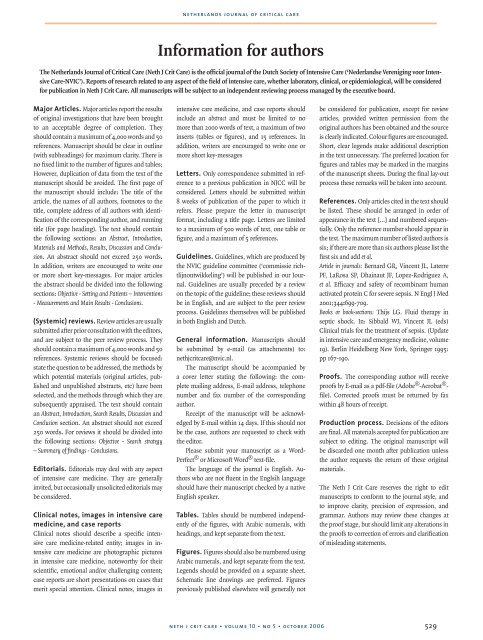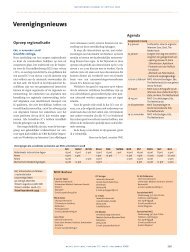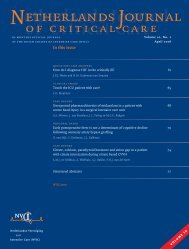Netherlands Journal
NJCC Volume 10, Oktober 2006
NJCC Volume 10, Oktober 2006
- No tags were found...
You also want an ePaper? Increase the reach of your titles
YUMPU automatically turns print PDFs into web optimized ePapers that Google loves.
netherlands journal of critical care<br />
Information for authors<br />
The <strong>Netherlands</strong> <strong>Journal</strong> of Critical Care (Neth J Crit Care) is the official journal of the Dutch Society of Intensive Care (‘Nederlandse Vereniging voor Intensive<br />
Care-NVIC’). Reports of research related to any aspect of the field of intensive care, whether laboratory, clinical, or epidemiological, will be considered<br />
for publication in Neth J Crit Care. All manuscripts will be subject to an independent reviewing process managed by the executive board.<br />
Major Articles. Major articles report the results<br />
of original investigations that have been brought<br />
to an acceptable degree of completion. They<br />
should contain a maximum of 4,000 words and 50<br />
references. Manuscript should be clear in outline<br />
(with subheadings) for maximum clarity. There is<br />
no fixed limit to the number of figures and tables;<br />
However, duplication of data from the text of the<br />
manuscript should be avoided. The first page of<br />
the manuscript should include: The title of the<br />
article, the names of all authors, footnotes to the<br />
title, complete address of all authors with identification<br />
of the corresponding author, and running<br />
title (for page heading). The text should contain<br />
the following sections: an Abstract, Introduction,<br />
Materials and Methods, Results, Discussion and Conclusion.<br />
An abstract should not exceed 250 words.<br />
In addition, writers are encouraged to write one<br />
or more short key-messages. For major articles<br />
the abstract should be divided into the following<br />
sections: Objective - Setting and Patients – Interventions<br />
- Measurements and Main Results - Conclusions.<br />
(Systemic) reviews. Review articles are usually<br />
submitted after prior consultation with the editors,<br />
and are subject to the peer review process. They<br />
should contain a maximum of 4,000 words and 50<br />
references. Systemic reviews should be focused:<br />
state the question to be addressed, the methods by<br />
which potential materials (original articles, published<br />
and unpublished abstracts, etc) have been<br />
selected, and the methods through which they are<br />
subsequently appraised. The text should contain<br />
an Abstract, Introduction, Search Results, Discussion and<br />
Conclusion section. An abstract should not exceed<br />
250 words. For reviews it should be divided into<br />
the following sections: Objective - Search strategy<br />
– Summary of findings - Conclusions.<br />
Editorials. Editorials may deal with any aspect<br />
of intensive care medicine. They are generally<br />
invited, but occasionally unsolicited editorials may<br />
be considered.<br />
Clinical notes, images in intensive care<br />
medicine, and case reports<br />
Clinical notes should describe a specific intensive<br />
care medicine-related entity; images in intensive<br />
care medicine are photographic pictures<br />
in intensive care medicine, noteworthy for their<br />
scientific, emotional and/or challenging content;<br />
case reports are short presentations on cases that<br />
merit special attention. Clinical notes, images in<br />
intensive care medicine, and case reports should<br />
include an abstract and must be limited to no<br />
more than 2000 words of text, a maximum of two<br />
inserts (tables or figures), and 15 references. In<br />
addition, writers are encouraged to write one or<br />
more short key-messages<br />
Letters. Only correspondence submitted in reference<br />
to a previous publication in NJCC will be<br />
considered. Letters should be submitted within<br />
8 weeks of publication of the paper to which it<br />
refers. Please prepare the letter in manuscript<br />
format, including a title page. Letters are limited<br />
to a maximum of 500 words of text, one table or<br />
figure, and a maximum of 5 references.<br />
Guidelines. Guidelines, which are produced by<br />
the NVIC guideline committee (‘commissie richtlijnontwikkeling’)<br />
will be published in our <strong>Journal</strong>.<br />
Guidelines are usually preceded by a review<br />
on the topic of the guideline; these reviews should<br />
be in English, and are subject to the peer review<br />
process. Guidelines themselves will be published<br />
in both English and Dutch.<br />
General information. Manuscripts should<br />
be submitted by e-mail (as attachments) to:<br />
nethjcritcare@nvic.nl.<br />
The manuscript should be accompanied by<br />
a cover letter stating the following: the complete<br />
mailing address, E-mail address, telephone<br />
number and fax number of the corresponding<br />
author.<br />
Receipt of the manuscript will be acknowledged<br />
by E-mail within 14 days. If this should not<br />
be the case, authors are requested to check with<br />
the editor.<br />
Please submit your manuscript as a Word-<br />
Perfect ® or Microsoft Word ® text-file.<br />
The language of the journal is English. Authors<br />
who are not fluent in the Englsih language<br />
should have their manuscript checked by a native<br />
English speaker.<br />
Tables. Tables should be numbered independently<br />
of the figures, with Arabic numerals, with<br />
headings, and kept separate from the text.<br />
Figures. Figures should also be numbered using<br />
Arabic numerals, and kept separate from the text.<br />
Legends should be provided on a separate sheet.<br />
Schematic line drawings are preferred. Figures<br />
previously published elsewhere will generally not<br />
be considered for publication, except for review<br />
articles, provided written permission from the<br />
original authors has been obtained and the source<br />
is clearly indicated. Colour figures are encouraged.<br />
Short, clear legends make additional description<br />
in the text unnecessary. The preferred location for<br />
figures and tables may be marked in the margins<br />
of the manuscript sheets. During the final lay-out<br />
process these remarks will be taken into account.<br />
References. Only articles cited in the text should<br />
be listed. These should be arranged in order of<br />
appearance in the text […] and numbered sequentially.<br />
Only the reference number should appear in<br />
the text. The maximum number of listed authors is<br />
six; if there are more than six authors please list the<br />
first six and add et al.<br />
Article in journals: Bernard GR, Vincent JL, Laterre<br />
PF, LaRosa SP, Dhainaut JF, Lopez-Rodriguez A,<br />
et al. Efficacy and safety of recombinant human<br />
activated protein C for severe sepsis. N Engl J Med<br />
2001;344:699-709.<br />
Books or book-sections: Thijs LG. Fluid therapy in<br />
septic shock. In: Sibbald WJ, Vincent JL (eds)<br />
Clinical trials for the treatment of sepsis. (Update<br />
in intensive care and emergency medicine, volume<br />
19). Berlin Heidelberg New York, Springer 1995:<br />
pp 167-190.<br />
Proofs. The corresponding author will receive<br />
proofs by E-mail as a pdf-file (Adobe ® -Acrobat ® -<br />
file). Corrected proofs must be returned by fax<br />
within 48 hours of receipt.<br />
Production process. Decisions of the editors<br />
are final. All materials accepted for publication are<br />
subject to editing. The original manuscript will<br />
be discarded one month after publication unless<br />
the author requests the return of these original<br />
materials.<br />
The Neth J Crit Care reserves the right to edit<br />
manuscripts to conform to the journal style, and<br />
to improve clarity, precision of expression, and<br />
grammar. Authors may review these changes at<br />
the proof stage, but should limit any alterations in<br />
the proofs to correction of errors and clarification<br />
of misleading statements.<br />
neth j crit care • volume 10 • no 5 • october 2006<br />
529







